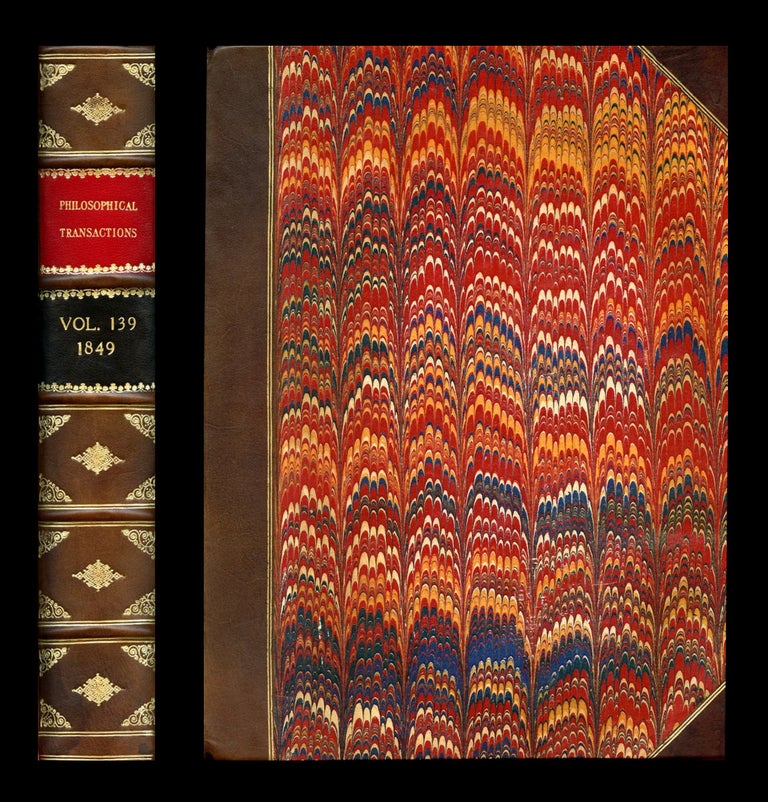The Bakerian Lecture. Experimental Researches in Electricity Twenty-Second Series: On the crystalline polarity of bismuth and other bodies, and on its relation to the magnetic form of force AND Experimental Researches in Electricity Twenty-Second Series: On the crystalline polarity of bismuth and other bodies, and on its relation to the magnetic form of force, Part II (Faraday: pp. 1-18 and pp. 19-41) WITH On the Motion of Gases (Graham: pp. 349-393) WITH Additional Observations on the Osteology of the Iguanodon and Hylaeosaurus (Mantell, pp. 271-307) in Philosophical Transactions of the Royal Society of London Parts 1 & 2, Volume 139, 1849, pp. 1-18 and pp. 19-41.
London: Royal Society, 1849. 1st Edition. FIRST EDITION OF TWO IMPORTANT PAPERS BY MICHAEL FARADAY, EACH PUBLISHED AS PART OF HIS LANDMARK TWENTY-NINE PAPER “EXPERIMENTAL RESEARCHES IN ELECTRICITY” SERIES. Also included, a significant paper by Thomas Graham on the motion of gases; also, an important paper by Gideon Mantell on the iguanodon. Handsomely bound, the volume is complete with Parts 1 & 2 and includes 43 plates.
FARADAY: Faraday discusses magneto-crystallic force and the abnormal behavior of various crystals in a magnetic field. Faraday “hoped that when ‘properly understood’ the various phenomena examined in terms of their magnecrystallic, crystallographic and optic axes would come under ‘one law [that] will include all these phenomena’” (Kox, No Truth Except in the Details). Faraday was an English chemist and physicist often thought to be the best experimentalist in the history of science.
During Faraday’s earlier experiments on electro-magnetical theory he had “observed some phenomena that led him to a belief in the existence of another form of force, distinct from either paramagnetic or diamagnetic force, which he called the magne-crystallic force. He had been experimenting with some slender needles of bismuth, suspending them horizontally between the poles of an electro-magnet. Taking a few of these cylinders at random from a greater number, he was much perplexed to find that they did not all come to rest equatorially, as well-behaved bars of diamagnetic bismuth should do, though, if subjected to the action of a single magnetic pole, they did show this diamagnetic character by their marked repulsion. After much experimentation, he ascribed this phenomenon to the crystalline condition of the cylinder. By experimenting with carefully selected groups of crystals of bismuth, he believed he could trace the cause of the phenomenon to the action of a force which he called the magne-crystallic force” (Houston, “Electricity and Magnetism”). We separately offer this paper dis-bound.
GRAHAM: Graham was the first to carry out diffusion experiments on gases and in 1833 stated what is now called Graham’s law of diffusion. The paper included here, “On the Motion of Gases” reports “a phenomenon which he named effusion of gases into a vacuum through a thin plate, “leaving no doubt of the truth of the general law, that different gases pass through minute apertures into a vacuum in times which are as the square roots of their respective specific gravities, or with velocities which are inversely as the square roots of their specific gravities,” and that “the effusion-time of air of different temperatures is proportional to the square root of its density at each temperature” (Science Direct, 24, 2, 2013).
MANTELL: Gideon Mantell “is best known for his discovery of the first dinosaur ever to be described properly – “a momentous event” and noted that the Iguanodon “was the first dinosaur ever to be described properly” (Dictionary of Scientific Biography, IX, 87). This paper supplements Mantell’s earlier papers and comprises an account of some important additions which he has lately made to our previous knowledge of the osteological structure of the colossal reptiles.
ALSO INCLUDED: Richard Owen’s On the development and homologies of the carapace and plastron of the chelonian reptiles. Item #1446
CONDITION & DETAILS: Philosophical Transactions Parts 1 & 2 for the year 1849. Complete Ex-libris with bearing only two Royal College of Surgeons stamps. 4to. (11.5 by 9 inches; 288 x 225mm). [18], 523, [1], 15 , [4]. 43 plates. Handsomely rebound in aged calf. 5 raised bands at the spine, each gilt-ruled; gilt-tooled fleur-de-lis at the spine. Red and black, gilt-lettered spine labels. Tightly bound with new endpapers Very slight toning within. By any measure, near fine condition inside and out.
Price: $625.00

